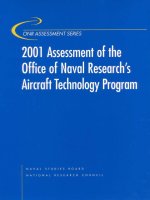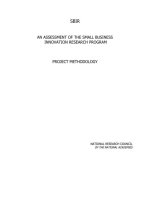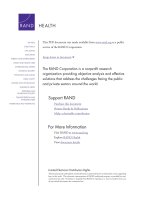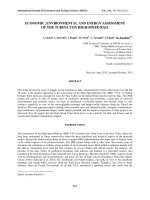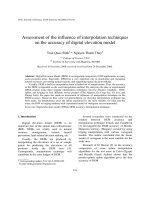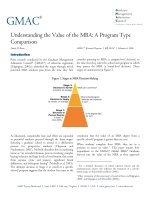Technical Assessment of the Man-in-Simulant Test Program potx
Bạn đang xem bản rút gọn của tài liệu. Xem và tải ngay bản đầy đủ của tài liệu tại đây (131.62 KB, 8 trang )
Technical Assessment of the Man-in-Simulant Test Program (Free Executive Summary)
/>Free Executive Summary
ISBN: , 86 pages, 6 x 9, paperback (1997)
This executive summary plus thousands more available at www.nap.edu.
Technical Assessment of the Man-in-Simulant Test
Program
Standing Committee on Program and Technical Review
of the U.S. Army Chemical and Biological Defense
Command, National Research Council
This free executive summary is provided by the National Academies as
part of our mission to educate the world on issues of science, engineering,
and health. If you are interested in reading the full book, please visit us
online at . You may browse and
search the full, authoritative version for free; you may also purchase a print
or electronic version of the book. If you have questions or just want more
information about the books published by the National Academies Press,
please contact our customer service department toll-free at 888-624-8373.
Copyright © National Academy of Sciences. All rights reserved. Unless otherwise
indicated, all materials in this PDF file are copyrighted by the National Academy of
Sciences. Distribution or copying is strictly prohibited without permission of the National
Academies Press Permission is granted for this material
to be posted on a secure password-protected Web site. The content may not be posted
on a public Web site.
Copyright © National Academy of Sciences. All rights reserved.
This executive summary plus thousands more available at
Technical Assessment of the Man-in-Simulant Test Program
/>Executive Summary
In 1993 the U.S. Army established the Chemical and Biological Defense
Command (CBDCOM) to conduct research, develop and procure support
systems, and design equipment to protect U.S. military personnel from the
increasing threat by foreign entities and terrorist organizations to use chemical
and biological weapons. CBDCOM is the latest in a long history of military
organizations designated for chemical and biological defense research. Because
of the critical nature of its mission, the CBDCOM requested that the National
Research Council (NRC) establish an oversight committee of nationally
recognized experts to provide ongoing, impartial, independent advice and
assessments.
The NRC, responding through the Board on Army Science and
Technology of the Commission on Engineering and Technical Systems, created
a standing committee called the Program and Technical Review of the U.S.
Army Chemical and Biological Defense Command, better known as the
CBDCOM Standing Committee (CSC). This committee was assembled to
provide expertise in the areas of science and technology pertinent to the
concerns of the CBDCOM commander and executive director and the technical
director of the Edgewood Research, Development and Engineering Center
(RDEC), which historically has been an important organization in the Army and
Department of Defense for chemical and biological research.
The U.S Army has not established specific requirements for the chemical
protective qualities of its ensembles (chemical protective ensembles, or CPEs).
This is because test results (protection factors) have never been correlated with
biological endpoints. Instead, new CPEs have been evaluated in comparison to
the CPE currently in the
EXECUTIVE SUMMARY 1
About this PDF file: This new digital representation of the original work has been recomposed from XML files created from the original paper book, not from the
original typesetting files. Page breaks are true to the original; line lengths, word breaks, heading styles, and other typesetting-specific formatting, however, cannot be
retained, and some typographic errors may have been accidentally inserted. Please use the print version of this publication as the authoritative version for attribution.
Copyright © National Academy of Sciences. All rights reserved.
This executive summary plus thousands more available at
Technical Assessment of the Man-in-Simulant Test Program
/>field (e.g., the battle dress overgarment, BDO). The goal of the Army's program
has been to increase chemical protection factors while decreasing undesirable
properties (weight and heat stress), although there is no clear understanding of
how much chemical protection would be enough to maintain battlefield
effectiveness. The man-in-simulant test program (MIST) is responsible for
specifying protection factors, but it does not, by itself, link them to biological
effects and has not answered the CPE developer's question of how much
protection is enough.
The cornerstone of chemical and biological defense strategy is protection
(i.e., insulating personnel from chemical and biological agents using individual
clothing ensembles and respirators, as well as collective filtration systems and
shelters). The CSC was asked by the CBDCOM to undertake a technology
assessment of the Army's MIST program—which is designed to test protective
suit ensembles in simulated chemical attacks. Specifically, the CSC was asked to:
1. review the test methodology for the man-in-simulant test program
1
2. review the use of biological markers (e.g., cholinesterase
inhibition) to predict the signs and symptoms associated with
exposure to nerve (VX) and vesicant (HD) agents
3. review the test methodology for employing passive and active
vapor and aerosol samplers during simulant tests at Dugway
Proving Ground, Utah, and assess the plan for data collection and
analysis
4. determine whether the current chemical simulant, methyl salicylate,
or an alternative simulant should be used in the MIST program
To accomplish this task the CSC established a panel of experts from
members of the committee to undertake the MIST review. The panel has
addressed each item on the list and has summarized the conclusions and
recommendations below. The background information and rationale behind
these findings are detailed in the full report.
1
The original statement of task for Task 1 included ''and the rationale for using methyl
salicylate as a chemical agent simulant in this test program.'' The committee felt that this
aspect of the review was reiterated in Task 4 and has addressed the question there.
EXECUTIVE SUMMARY 2
About this PDF file: This new digital representation of the original work has been recomposed from XML files created from the original paper book, not from the
original typesetting files. Page breaks are true to the original; line lengths, word breaks, heading styles, and other typesetting-specific formatting, however, cannot be
retained, and some typographic errors may have been accidentally inserted. Please use the print version of this publication as the authoritative version for attribution.
Copyright © National Academy of Sciences. All rights reserved.
This executive summary plus thousands more available at
Technical Assessment of the Man-in-Simulant Test Program
/>TASK 1. Review the test methodology for the man-in-simulant test program.
Conclusion 1. The MIST is a well-designed test protocol for evaluating
chemical protective ensembles. However, the committee found that the test
methodology was not based on preliminary testing that would eliminate
ensembles with gross defects and allow more replications of tests be done on
fewer candidate protective ensembles, thereby increasing the statistical power
of the results.
Recommendation 1. The Army should screen ensembles prior to a full-
blown MIST by video imaging the skin of test subjects after exposure to a
fluorescent tracer or other physical tests. Screening should also include
variations in ambient conditions (temperature, humidity, wind, and, perhaps,
rain), activities (kneeling, sitting, and crawling), and sweat-soaked and dry test
challenges.
TASK 2. Review the use of biological markers (e.g., cholinesterase
inhibition) to predict the signs and symptoms associated with exposure to nerve
(VX) and vesicant (HD) agents.
Conclusion 2. Body region hazard analysis (BRHA) is an innovative
approach that takes into account regional variations in skin sensitivity to
chemical agents. Although the basic approach is sound, the committee has the
following reservations:
• A direct relationship has not been established between cholinesterase
depression and the percutaneous absorption of agent.
• The relationship between liquid and vapor absorption has not been
determined.
• BRHA was based on the local absorption of VX and may not
accurately predict the absorption of HD.
• BRHA does not account for functional impairments from mustard-
induced lesions in various body regions.
• BRHA does not account for individual differences in sensitivity to
chemical agents.
A direct determinant of the toxicity of a chemical agent is the permeability
of the skin by that agent at a given anatomic site.
EXECUTIVE SUMMARY 3
About this PDF file: This new digital representation of the original work has been recomposed from XML files created from the original paper book, not from the
original typesetting files. Page breaks are true to the original; line lengths, word breaks, heading styles, and other typesetting-specific formatting, however, cannot be
retained, and some typographic errors may have been accidentally inserted. Please use the print version of this publication as the authoritative version for attribution.
Copyright © National Academy of Sciences. All rights reserved.
This executive summary plus thousands more available at
Technical Assessment of the Man-in-Simulant Test Program
/>Therefore, the committee concluded that rather than basing the BRHA on
highly variable indirect measures (cholinesterase depression) and assumptions,
a protocol should be designed to quantify the in vitro agent permeability of
excised human skin samples from different body regions. These techniques are
well established and well accepted and could also be used to compare simulant
uptake by human skin and passive samplers. Large differences may indicate a
need to redesign the samplers. The vapor uptake of agent and simulant could
also be determined for human skin and passive samplers. Large differences in
the behavior of agent and simulant may warrant the selection of a different
simulant or adjustments in the methods used to calculate protection factors.
Recommendation 2a. The Army should measure regional variations in
skin penetration for HD, VX, and simulant vapors using excised human skin
harvested from various anatomic sites.
Recommendation 2b. As a supplemental validation of the systematic
BRHA, a biomonitoring protocol should be developed for the MIST, analogous
to the protocol used to monitor pesticide exposures to agricultural workers. If
the appropriate simulant is used, the calibrations obtained from in vitro studies
could be used to relate suit performance to physiological effects based on the
absorbed dose.
TASK 3. Review the test methodology for employing passive and active
vapor and aerosol samplers during simulant tests and assess the data collection
and analysis plan.
Conclusion 3. Passive samplers are appropriate means for testing for the
presence of vapor. The protocol, however, may not be valid for aerosols
because the disposition of chemical agents in aerosol and vapor forms can be
quite different. From the information recorded in the documents given to the
committee for review, the committee could not confirm the uniformity of
simulant concentration within the test chamber. Variations in concentration
outside the protective ensemble could lead to errors in assessing the protective
qualities of the suit.
Although passive samplers are generally regarded as less accurate than
active samplers in bench trials, the differences in the results are
EXECUTIVE SUMMARY 4
About this PDF file: This new digital representation of the original work has been recomposed from XML files created from the original paper book, not from the
original typesetting files. Page breaks are true to the original; line lengths, word breaks, heading styles, and other typesetting-specific formatting, however, cannot be
retained, and some typographic errors may have been accidentally inserted. Please use the print version of this publication as the authoritative version for attribution.
Copyright © National Academy of Sciences. All rights reserved.
This executive summary plus thousands more available at
Technical Assessment of the Man-in-Simulant Test Program
/>small. The precision and accuracy of the Natick sampler is adequate for the
intended purpose. The small size of the Natick sampler enables testing under
the suit without incurring a number of disadvantages (outlined in Chapter 4)
that would be incurred with active sampler pumps either inside or outside the
suit.
A residual disadvantage of passive samplers may be a lack of sensitivity to
brief variations in concentration, which would be of interest only for identifying
the body positions or activities associated with leakage. Conventional active
samplers would have the same disadvantage, but external samplers connected to
a near-real-time monitor could provide this information.
Recommendation 3. Agent uniformity in all parts of the test chamber
throughout the duration of the tests should be documented. In addition,
concentrations inside the suit could be monitored with either active or passive
samplers, despite their logistical problems. Comparing simulant levels in the
passive sampler with samples recovered from the stratum corneum of test
subjects (the outermost layer of the skin, which can be removed by repeated
applications of adhesive tape) would provide insights into sampler performance.
TASK 4. Determine whether the current chemical simulant, methyl
salicylate, or an alternative simulant should be used in the MIST program.
Conclusion 4. Methyl salicylate is an appropriate simulant for the
transport of chemical agent into protective ensembles. However, biological
interpretations of the MIST/BRHA using methyl salicylate are not warranted.
Recommendation 4. Additional studies should be undertaken to establish
absorption and transport properties of the simulant relative to the properties of
the agents. In vitro studies using excised skin and mannequin studies (capable
of simulating a bellows effect) can be used to accomplish this objective. With
the appropriate consent and the oversight of a human use committee, excised
human skin can be used for research. Samples can be obtained from cadavers or
from surgical samples (e.g., abdominal skin, facial skin, etc.) Large differences
in distributions may warrant that an alternative simulant be used.
EXECUTIVE SUMMARY 5
About this PDF file: This new digital representation of the original work has been recomposed from XML files created from the original paper book, not from the
original typesetting files. Page breaks are true to the original; line lengths, word breaks, heading styles, and other typesetting-specific formatting, however, cannot be
retained, and some typographic errors may have been accidentally inserted. Please use the print version of this publication as the authoritative version for attribution.
Copyright © National Academy of Sciences. All rights reserved.
This executive summary plus thousands more available at
Technical Assessment of the Man-in-Simulant Test Program
/>GENERAL CONCLUSIONS AND RECOMMENDATIONS
General Conclusion 1. The first step in chemical and biological defense
strategy is early detection and warning to provide situational awareness and
permit steps to be taken to avoid the exposure of personnel and equipment. The
complement to detection is protection. Chemical protective ensembles, as well
as collective filtration systems and shelters, are used to insulate personnel from
chemical and biological agents. Modeling chemical protective ensembles is a
daunting task, and the Army's efforts to develop the MIST/BRHA should be
commended. Modeling and simulation technologies are invaluable tools for
training for operations in a chemical and biological warfare environment. They
provide material and equipment design parameters and enable field
commanders to integrate and interpret real-time data. However, deriving
physiological endpoints from the MIST/BRHA is a complicated process that
will require cooperation among the Army's scientists, as well as significant
input from academia and industry.
General Recommendation 1. The development of new test
methodologies should be done separately from routine ensemble testing. Once
the criteria for suit performance have been established, decision points should
be entered in a flow chart to reveal where additional work is needed. As of this
writing, the Army has not adopted a clear approach to establishing physiologic
endpoints from protective ensemble testing. However, this is an achievable goal
that should be pursued to protect soldiers
General Conclusion 2. The Army should ensure better cooperation among
various disciplines (i.e., chemistry, toxicology, engineering, human factors,
etc.). For example, scientists in CBDCOM's toxicology division have not
participated in any significant way in the development of ensemble test methods.
General Recommendation 2. More integration between the various
groups and technical disciplines will be essential for the development of future
testing methodologies. All relevant parties should participate in the planning
phase with the objective of reaching a consensus on research objectives, design
procedures, analysis, and documentation.
EXECUTIVE SUMMARY 6
About this PDF file: This new digital representation of the original work has been recomposed from XML files created from the original paper book, not from the
original typesetting files. Page breaks are true to the original; line lengths, word breaks, heading styles, and other typesetting-specific formatting, however, cannot be
retained, and some typographic errors may have been accidentally inserted. Please use the print version of this publication as the authoritative version for attribution.
Copyright © National Academy of Sciences. All rights reserved.
This executive summary plus thousands more available at
Technical Assessment of the Man-in-Simulant Test Program
/>
